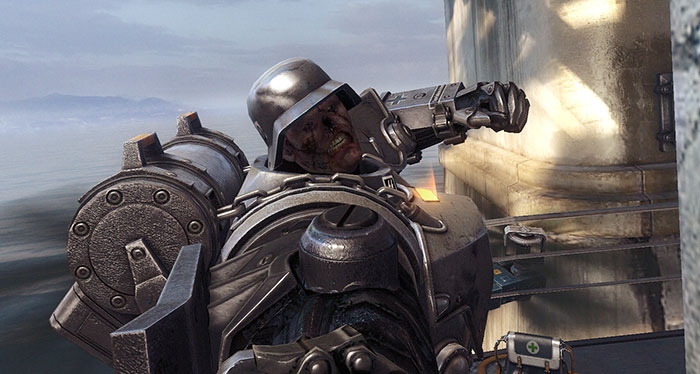Umpteenth sequels to ancient first-person shooters aren’t supposed to be any good. Especially when they stick to retro big dumb action values while playing it completely straight. Wolfenstein: The New Order is a game about shooting giant robot Nazis in the 1960s, for goodness’ sakes, but it doesn’t stop and laugh at itself even once. And it absolutely gets away with it. It’s a strange beast indeed, this one. On paper, almost everything it does is ridiculous – mechanical guard dogs, trips to the moon, secret Hebrew technology, escaping a concentration camp in a robo-suit, a hero who repeatedly walks away from fatal wounds, stopping to make coffee on a Nazi-occupied train… The New Order could have gone for self-satire, as we’ve seen semi-successfully in last year’s Shadow Warrior and disastrously in the atrocious Duke Nukem Forever, but instead it twins its b-movie values with a surprisingly reflective and sad plot. Hero BJ Blazkowicz may be the same musclebound lunkhead who’s been this series star since 1992’s Wolfestein 2D (the grandaddy of shooters), but now he’s scarred by loss, regret and the knowledge that he spent a decade in a half languishing in an asylum while the Nazis won World War II. He’s horrified by their atrocities, he’s guilt-stricken by his failure to stop the mad scientist whose technology brought about that dark victory, and he’s determined to protect those he cares about. It’s still shlock, inevitably, and the game wildly switches between a laser-focus on its supporting cast and ignoring them for ages at a time, but somehow it all hangs together. It’s an engrossing, expensive-feeling adventure – one which lasts about twice as long as your average contemporary FPS singleplayer campain, and which boasts excellent action too.
It’s got a big but not too big arsenal , and is careful to ensure every weapon retains a specific purpose throughout, plus it even offers a choice of approaches. The idea of stealth in a series which has always been about Arnie-style heroics is faintly absurd, but Wolfenstein pulls off silent stabbings, a simple (and optional) cover system and muffled pistol headshots rather well. When skulking in the shadows goes wrong, the fallback is open and explosive gunplay, often in large and semi-open environments, so it’s an impressively changeable experience. A perks system also grants unlocks mostly as a result of simply playing in the way you prefer, while a dark decision made in the earliest hours of the game opens up or shuts off a few options. The New Order just about justifies a second playthrough for this reason, although you’ll probably end up with most of the perks in a single campaign anyway. Trying hard to justify its status as a singleplayer game, it also throws all it can at you in terms of settings and setpiece scenes – rarely does The New Order regress into dull corridors and warehouses. A few moments clunk, however, particularly when it tries to show a concentration camp as simultaneously horrific and silly sci-fi, while sometimes it forces stealth or assault on you whether you want it to or not. Be warned that it’s also big on gruesome scenes of torture and mutilation, which sometimes drag its tone from comic book romp into jarring sadism. Still, much as the tone spikes all over the place, this is a solid, substantial and satisfying shooter which carefully avoids so many of the follies of its peers – no following AI characters around, no backtracking, no infinitely-respawning enemies, and just about avoiding a cutscene overload. It’s perhaps churlish to claim that The New Order is far better than it has any right to be – after all, this is a series with serious heritage – but it’s certainly a big and pleasant surprise to find that something so preposterous is so very well done.

